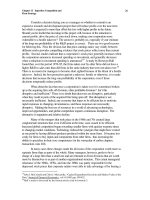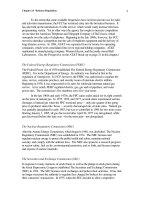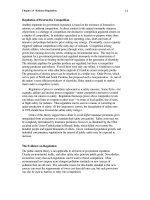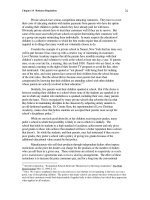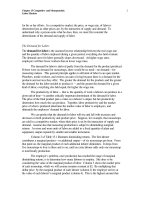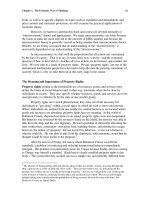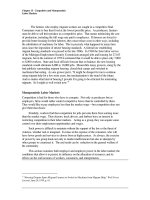MicroEconomics chap004
Bạn đang xem bản rút gọn của tài liệu. Xem và tải ngay bản đầy đủ của tài liệu tại đây (257.63 KB, 20 trang )
Chapter 4: Basic Estimation
Techniques
McGraw-Hill/Irwin
Copyright © 2011 by the McGraw-Hill Companies, Inc. All rights reserved.
Basic Estimation
• Parameters
• The coefficients in an equation that determine
the exact mathematical relation among the
variables
• Parameter estimation
• The process of finding estimates of the
numerical values of the parameters of an
equation
4-2
Regression Analysis
• Regression analysis
• A statistical technique for estimating the
parameters of an equation and testing for
statistical significance
4-3
Simple Linear Regression
• Simple linear regression model relates
dependent variable Y to one independent
(or explanatory) variable X
Y = a + bX
• Intercept parameter (a) gives value of Y where
regression line crosses Y-axis (value of Y when X is
zero)
• Slope parameter (b) gives the change in Y
associated with a one-unit change in X:
b = ∆Y ∆X
4-4
Simple Linear Regression
• Parameter estimates are obtained by
choosing values of a & b that minimize the
sum of squared residuals
• The residual is the difference between the actual
and fitted values of Y: Yi – Ŷi
• The sample regression line is an estimate of
the true regression line
ˆ
Yˆ = aˆ + bX
4-5
Sample Regression Line
(Figure 4.2)
S
SSii == 60,000
60,000
70,000
60,000
ei
50,000
) sr all od( s el a S
20,000
10,000
•
•
40,000
30,000
•
Sample regression line
Ŝi = 11,573 + 4.9719A
•
ˆ Ŝ==46,376
46,376
S
i i
•
•
•
A
0
2,000
4,000
6,000
8,000
10,000
Advertising expenditures (dollars)
4-6
Unbiased Estimators
• The estimates â & bˆ do not generally equal
the
of avariables
&b
• âtrue
& bˆ values
are random
computed using
data from a random sample
• The distribution of values the estimates
might take is centered around the true
value of the parameter
4-7
Unbiased Estimators
• An estimator is unbiased if its average
value (or expected value) is equal to the
true value of the parameter
4-8
Relative Frequency Distribution*
(Figure 4.3)
Relative Frequency Distribution*
for bˆ when b = 5
ˆ
Relative frequency of b
1
0
1
2
3
4
5
6
7
8
9
10
ˆ
Least-squares estimate of b (b)
*Also called a probability density function (pdf)
4-9
Statistical Significance
• Must determine if there is sufficient
statistical evidence to indicate that Y is
truly related to X (i.e., b ≠ 0)
• Even if b = 0, it is possible that the
sample will produce an estimate bˆ that is
different from zero
• Test for statistical significance using
t-tests or p-values
4-10
Performing a t-Test
• First determine the level of significance
• Probability of finding a parameter estimate to
be statistically different from zero when, in
fact, it is zero
• Probability of a Type I Error
• 1 – level of significance = level of
confidence
4-11
Performing a t-Test
• t-ratio is computed as
bˆ
t=
Sbˆ
where Sbˆ is the standard error of the estimate bˆ
• Use t-table to choose critical t-value with
n – k degrees of freedom for the chosen
level of significance
n = number of observations
• k = number of parameters estimated
•
4-12
Performing a t-Test
• If the absolute value of t-ratio is greater
than the critical t, the parameter estimate
is statistically significant at the given
level of significance
4-13
Using p-Values
• Treat as statistically significant only those
parameter estimates with p-values smaller
than the maximum acceptable significance
level
• p-value gives exact level of significance
• Also the probability of finding significance
when none exists
4-14
Coefficient of Determination
• R2 measures the percentage of total
variation in the dependent variable (Y) that
is explained by the regression equation
• Ranges from 0 to 1
• High R2 indicates Y and X are highly
correlated
4-15
F-Test
• Used to test for significance of overall
regression equation
• Compare F-statistic to critical F-value from
F-table
• Two degrees of freedom, n – k & k – 1
• Level of significance
4-16
F-Test
• If F-statistic exceeds the critical F, the
regression equation overall is statistically
significant at the specified level of
significance
4-17
Multiple Regression
• Uses more than one explanatory variable
• Coefficient for each explanatory variable
measures the change in the dependent
variable associated with a one-unit change
in that explanatory variable, all else
constant
4-18
Quadratic Regression Models
• Use when curve fitting scatter plot is
U-shaped or ∩-shaped
• Y = a + bX + cX2
• For linear transformation compute new
variable Z = X2
• Estimate Y = a + bX + cZ
4-19
Log-Linear Regression Models
• Use when relation takes the form: Y = aXbZc
Percentage change in Y
•b=
Percentage change in X
Percentage change in Y
•c=
Percentage change in Z
• Transform by taking natural logarithms:
lnY = ln a + b ln X + c ln Z
• b and c are elasticities
4-20

